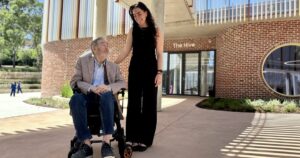
Genetic engineers have long faced the challenge of maintaining the functions of synthetic gene circuits as cells grow and divide. However, a groundbreaking discovery by researchers at Arizona State University (ASU) may provide a solution. By utilizing a natural principle, these scientists have found a way to protect these fragile genetic programs, ensuring their stability and functionality over time.
Xiaojun Tian, an associate professor in the School of Biological and Health Systems Engineering at ASU, along with his interdisciplinary team, has developed a technique that leverages the cell’s own organizational strategies. This innovative approach is detailed in a new paper published in Cell, where the researchers describe how forming small, droplet-like compartments inside cells can stabilize synthetic gene circuits.
Nature-Inspired Solutions for Synthetic Biology
The project, which draws on expertise in synthetic biology, modeling, and metabolic engineering, involves collaboration with David Nielsen, a chemical engineering professor, and Wenwei Zheng, an associate professor of chemistry, both part of ASU’s Fulton Schools of Engineering. Their research focuses on using a process known as liquid-liquid phase separation to create transcriptional condensates—microscopic droplets that act as molecular safe zones around key genes.
“When we try to program cells to perform useful tasks, such as diagnostics or therapeutic production, the genetic programs often fail because cell growth dilutes the key molecules needed to keep them running,” Tian explains. “We addressed this challenge by tapping into the cell’s own strategy of phase separation to protect engineered systems.”
Borrowing from Nature’s Playbook
Cells naturally use phase separation to organize their internal environment, creating compartments for essential biochemical reactions without membranes. Tian’s team realized that by mimicking this natural organization around synthetic genes, they could maintain genetic stability across various cell generations.
“We discovered that by forming tiny droplets called transcriptional condensates around genes, we can protect genetic programs and keep them stable even as cells grow,” Zheng notes. “It’s a simple physical solution that prevents dilution and keeps circuits running reliably.”
A New Design for Self-Stabilizing, Programmable Cells
This approach marks a significant departure from traditional strategies in synthetic biology, which have focused on tweaking DNA sequences or regulatory feedback loops. Instead of complex control systems, Tian’s team introduced a physical design principle that utilizes the existing spatial organization of molecules inside cells.
“Cells already use these droplets to regulate themselves,” Tian says. “We’re now harnessing the same strategy for synthetic biology.”
Adopting this methodology could help researchers build more reliable biological systems that maintain predictable, productive functions. “This opens a new way to build more reliable living systems, from stable cell factories to future medical applications,” Tian adds. “Our strategy can become a new design principle for researchers who need their engineered cells to work consistently.”
Images taken via microscope from the study show bright, glowing clusters of transcriptional condensates inside cells, which serve as visual proof that droplets can form precisely where needed to stabilize gene activity.
Sourcing Stability Through Collaboration
Tian’s group is already exploring how to engineer different kinds of condensates to control various genes, effectively turning them into programmable control hubs inside cells. “We want to program different condensates to control different genes, creating smart cells that can adapt and function long-term,” he says. “We’re learning how to design with the cell, not against it.”
This approach to designing in accordance with nature rather than trying to override it represents a key turning point in the field. The next step is to demonstrate the technique’s applications for more diverse implementations to determine resilience and scalability, though researchers see no shortage in potential applications.
“Researchers in synthetic biology who struggle with unstable circuits will see this as a new way to make their systems more reliable,” Zheng says. “Bioprocess engineers who want a consistent yield can also use it. For biophysicists like me, it’s exciting to see physical principles like phase separation turned into practical engineering tools.”
“This work reflects a new direction in synthetic biology,” Tian concludes. “By using the cell’s own organizing principles, we can build systems that are both powerful and inherently stable.”







